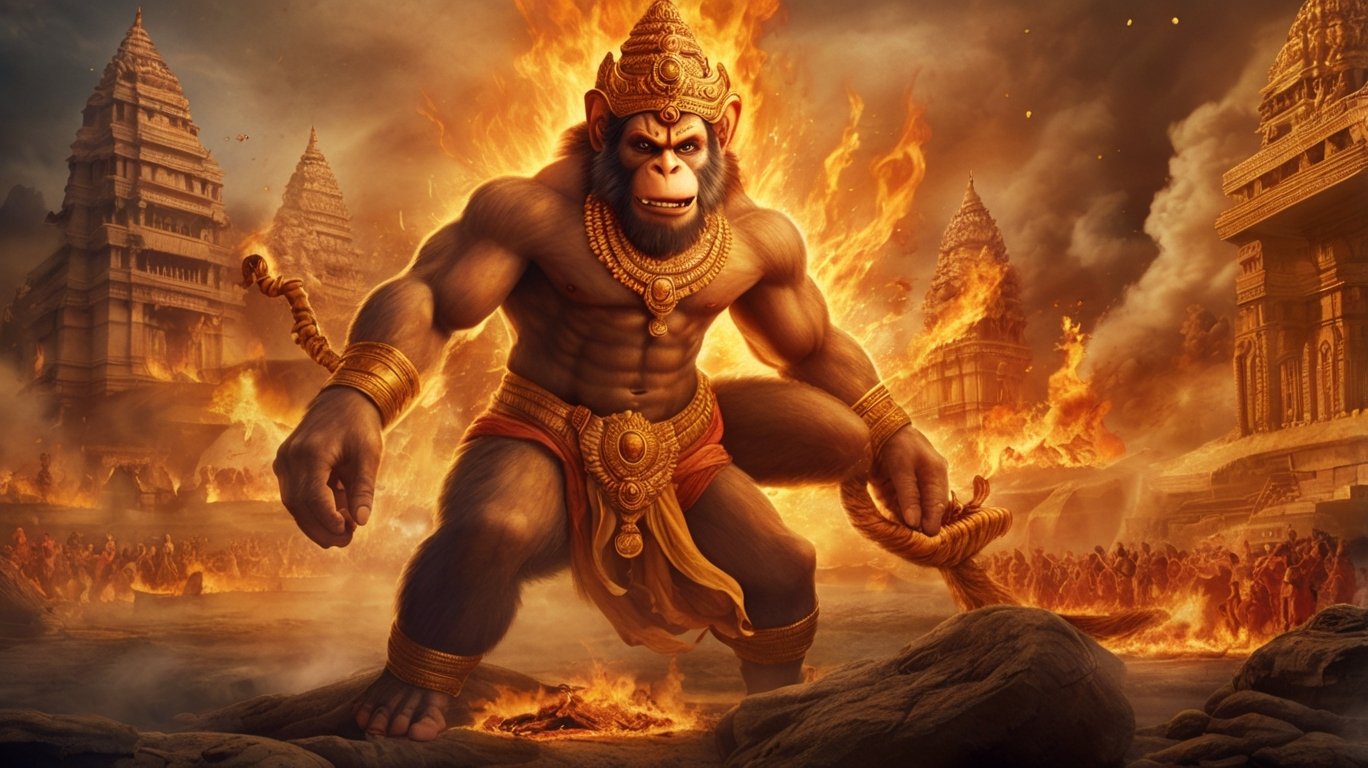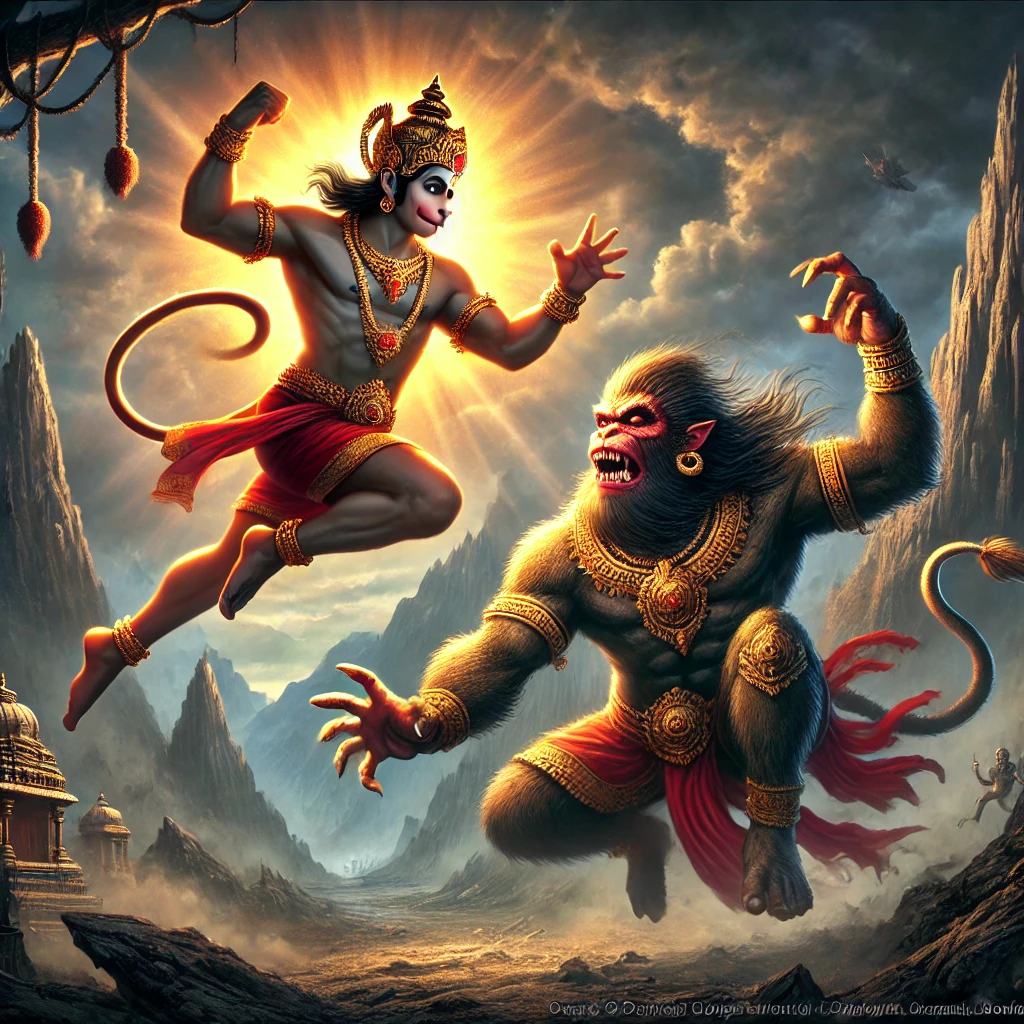Table of Contents
Introduction
Welcome to Bedesii.com, where we delve into the captivating tales and teachings of Lord Hanuman through the enchanting verses of Sundarkand! In this blog, we continue our journey through the sacred text, exploring the profound wisdom embedded in the verses that depict Hanuman’s daring exploits in Lanka.
In this segment, readers can expect to uncover the intricacies of Hanuman’s mission to find Sita and the trials he faces as he encounters various characters, including the formidable guardian, Lankini. We will break down each verse, providing clear and simple explanations that make these timeless stories accessible to all, regardless of familiarity with the text.
Join us as we unfold the narrative of bravery, devotion, and the pursuit of righteousness through Hanuman and Lankini’s encounter. This story illustrates how Hanuman’s unwavering faith in Lord Rama empowers him to overcome obstacles. Whether you are a long-time devotee or a curious newcomer, this blog promises to inspire and enlighten you with the heroic tales of Hanuman. Let us embark on this enlightening journey together!
Verses
Uma na kachu kapi kai adhikai, prabhu pratapa jo kalahi khai.
Giri para chadhi lanka tehi dekhi, kahi na ji ati durga bisesi.Ati utanga jalanidhi chahu pasa, kanaka kota kara parama prakasa.
Explanation
As Hanuman reached the shores of Lanka, he climbed a tall mountain to get a clear view of Ravana’s kingdom. From the peak, he saw the grand and powerful city of Lanka, surrounded on all sides by the vast ocean. The sight of the city was breathtaking.
Lanka’s defenses were impressive. It had strong golden walls that shone brightly in the sunlight, and the island was protected by the ocean like a natural barrier. The city looked both beautiful and dangerous.
However, Hanuman, blessed by Lord Rama, was not afraid. He knew that with Lord Rama’s strength and guidance, no obstacle was too great. The size and power of Lanka did not scare him. Instead, Hanuman’s focus remained firm on his mission to find Maa Sita.
In this moment, Hanuman’s courage and faith in Lord Rama gave him the strength to face any challenge. Even the most fortified city could not stop him because he was driven by divine purpose. His journey was a reminder that with faith and determination, no obstacle is impossible to overcome.
Chhand
Kanaka kota bichitra mani krta sundarayatana ghana,
Chauhatta hatta subatta bithi charu pura bahu bidhi bana.
Gaja baji khachchara nikara padachara ratha baruthanhi ko ganai,
Bahurupa nisichara jutha atibala sena baranata nahi banai.Bana baga upabana batika sara kupa bapi sohahi,
Nara naga sura gandharbha kanya rupa muni mana mohahi.
Kahu mala deha bisala saila samana atibala garjahi,
Nana akharenha bhirahi bahu bidhi eka ekanha tarjahi.Kari jatana bhata kotinha bikata tana nagara chahu disi racchahi,
Kahu mahisha manusha dhenu khara aja khala nisachara bhacchahi.
Ehi lagi tulasidasa inha ki katha kachu eka hai kahi,
Raghubira sara tiratha sariranhi tyagi gati paihahi sahi.
Explanation
As Hanuman arrived in Lanka, he marveled at the golden city built by demons, with its shining fortresses inlaid with precious stones. The streets were busy and well-constructed, filled with activity and prosperity. The marketplaces were bustling, and the city’s beauty was hard to miss, with its elaborate gardens and stunning architecture.
Lanka was alive with the movement of elephants, horses, camels, and soldiers. Chariots lined the streets, and many fierce demon warriors, in various terrifying forms, patrolled the city. Their immense strength was on full display as they moved about, roaring and intimidating others.
However, the city wasn’t just about power. Hanuman observed serene gardens, ponds, and lush groves, where even heavenly beings like the daughters of gods resided, their beauty capable of capturing the hearts of sages.
But the demons guarded the city fiercely. Some had massive bodies, comparable to mountains, and roared loudly. They were always ready for battle, boasting different weapons, with powerful guards stationed everywhere.
Despite the intimidating surroundings, Hanuman knew he had a higher mission to complete. The city’s beauty and its fierce warriors couldn’t distract him from his purpose—finding Sita and delivering Lord Rama’s message.
Doha
Pura rakhavare dekhi bahu kapi mana kinha bichara,
Ati laghu rupa dharau nisi nagara karau paisara.
As Hanuman stood at the gates of Lanka, he noticed the many guards patrolling the city. These fierce demon sentinels were strategically placed to prevent any intruders from entering. Seeing this, Hanuman began to think deeply about how to enter the heavily guarded city without being detected.
Using his wisdom and strength, Hanuman decided to shrink his form to a tiny size, much smaller than his usual mighty appearance. This allowed him to easily slip past the guards unnoticed during the night. His goal was to explore the city and gather information without causing a stir. With his small form, Hanuman stealthily entered Lanka, ready to continue his search for Sita.
This verse highlights Hanuman’s intelligence and adaptability. He didn’t rely solely on his physical strength but also on strategy to outsmart his enemies and continue his mission in the most efficient way possible.
Verses
Masaka samana rupa kapi dhari, Lankahi chaleu sumiri Narhari,
Nama Lankini eka nisichari, so kaha chalesi mohi nindari.Janehi nahi maramu satha mora, mor ahara jahaa lagi chora,
Muthika eka maha kapi hani, rudhira bamata dharani dhanamani.Puni sanbhari uthi so Lanka, jori paani kara binaya sanasaka,
Jaba ravanahi brahma bara dinha, chalata biranchi kah mohi chinha.Bikala hosi tai kapi ke mare, taba janesu nisichara sanghre,
Tata mora ati punya bahuta, dekheu nayana Rama kara duta.
Explanation
As Hanuman continued his journey in a tiny (Masaka – House Fly) form, he approached the mighty gates of Lanka, meditating upon Lord Narhari (a form of Vishnu). However, at the entrance, a demoness named Lankini, the guardian of Lanka, stopped him. She was puzzled and insulted by Hanuman’s attempt to enter the city unnoticed and demanded to know who he was and how he dared to pass without her permission.
Lankini, unaware of Hanuman’s divine mission, threatened him, saying that any thief who dared to cross her path would become her food. Hanuman, undeterred by her words, struck her with a powerful blow from his fist. The punch was so mighty that Lankini fell to the ground, bleeding, her strength shattered by Hanuman’s divine power.
After recovering from the blow, Lankini stood up, folding her hands in reverence. She recalled a prophecy given by Lord Brahma when he granted her a boon. Brahma had told her that when a monkey would defeat her, it would mark the beginning of Ravana’s downfall. Recognizing Hanuman as the messenger of Lord Rama, she became humble and admitted that her time had come. Lankini, realizing her good fortune, expressed that it was her great merit that she had the honor of seeing the divine messenger of Lord Rama.
This episode shows Hanuman’s immense power and how even the fiercest of opponents submit to the divine purpose he carries. Lankini’s recognition of her destiny reflects that even enemies have a role to play in the grand design of fate.
Doha
Tata svarga apabarga sukha dhari tula eka anga,
Tula na tahi sakala mili jo sukha lava satasanga.
This doha, emphasizes the incomparable joy and fulfillment derived from association with noble souls. The term “Tula” refers to a measure, suggesting that the happiness found in the company of such virtuous beings surpasses even the bliss experienced in heavenly realms (Svarga) or liberation (Apavarga).
The essence of the message is that true happiness cannot be quantified by material possessions or the pleasures of heaven; instead, it lies in the company and relationships we nurture with virtuous and enlightened individuals.
This idea resonates deeply within spiritual traditions, where the company of the wise and the righteous is seen as a source of inspiration and upliftment. Therefore, it serves as a reminder to seek out those who embody positive qualities and share our journeys, as their presence can enhance our own happiness and spiritual growth immensely.
Verses
Prabisi nagara kije saba kaja, hridaya rakhi kosalapura raja.
Garala sudha ripu karahi mitai, gopada sindhu anala sitalai.Garura sumeru renu sama tahi, rama kripa kari chitava jahi.
Ati laghu rupa dhareu hanumana, paitha nagar sumiri bhagwana.Mandira mandira prati kari sodha, dekhe jaha taha aganita jodha.
Gayau dasanana mandira mahi, ati bichitra kahi jat so nahi.Sayaan kiye dekha kapi tehi, mamdira mahu na dikhi baidehi.
Bhavan ek puni dikha suhava, hari mamdira taha bhinna banawa.

Explanation
In these verses, Hanuman enters the city of Lanka, carrying the weight of his mission in his heart. The first verse depicts the atmosphere in the city as Hanuman prepares for the task ahead. He understands the importance of staying focused and remembers the virtues of King Dasharatha, invoking Lord Rama’s name for guidance. The metaphor of “garala sudha” suggests that he seeks to transform the bitterness of his enemies into sweetness, showcasing his commitment to righteousness.
In the second verse, Hanuman assumes a small form to move stealthily through the city, illustrating both his humility and wisdom. The reference to “Garura” and “Sumeru” indicates that he draws strength from divine blessings, emphasizing the need for devotion and grace in one’s endeavors.
As he inspects the magnificent buildings and temples in Lanka in the third verse, he recognizes the power and beauty of his enemies but remains undeterred. The mention of Dashanana (Ravana) hints at his formidable presence, yet Hanuman is not intimidated.
In the final verse, Hanuman’s keen observation skills are highlighted as he notes the temples but fails to see Sita. This deepens the narrative of his mission and sets the stage for the ensuing events, reflecting his unwavering focus on finding Sita and delivering her message to Lord Rama. Overall, these verses encapsulate Hanuman’s determination, intelligence, and devotion as he navigates the challenges in Lanka.
Doha
Ramayudha ankit graha sobha barani na jai,
nava tulasika brinda taha dekhi harasha kapirai.
Explanation
In this doha, Hanuman observes the beauty and splendor of the palaces adorned with Lord Rama’s insignia, signifying the divine presence and authority of Lord Rama in the land. The phrase “Ramayudha ankit graha” suggests that the houses and structures in Lanka are marked by the power of Rama’s weapon, the bow, symbolizing his strength and divine right. This marks a poignant moment for Hanuman as he realizes the profound connection between his mission and Lord Rama’s legacy.
The second line, “nava tulasika brinda taha dekhi harasha kapirai,” refers to the sight of fresh tulasi plants, which are sacred in Hindu tradition and are closely associated with Lord Rama and his devotion. The presence of these plants brings joy to Hanuman, representing hope and the promise of righteousness. Tulasi is often seen as a symbol of purity and devotion, and its appearance serves as a reminder of the sacred bond between Lord Rama and his devotees.
Overall, this doha encapsulates Hanuman’s reverence for Lord Rama and the deep connection he feels as he embarks on his crucial mission to find Sita. It highlights the joy and strength he derives from witnessing elements that symbolize Rama’s presence, reinforcing his determination to fulfill his duty.
Verses
lanka nisichara nikara nivasa, inha kar sajjan kar basa.
mana mahu taraka karai kapi laga, tehi samay vibhishanu jaga.Rama Rama tehi sumirana kinha, hridayam harash kapi sajjan cheenha.
ehi sana hathi karihau pahicani, sadhu ke hoyi na karaj hani.bipra rupa dhari bachana sunri, sunata bibhshana uthi taha ae.
kari pranama puchi kusalai, ki tumha hari dasanha maha koi.ki tumha hari dasanha maha koi, more hridaya priti ati hoi.
ki tumha ramu dina anurgi, ayahu mohi karana barabhagi.
Explanation
In these verses, Hanuman finds himself in the heart of Lanka, surrounded by the demons (Nishacharas) who dwell there. As he observes their residence, he feels an urge to be cautious, for he is aware of the formidable nature of his surroundings. At this moment, Vibhishana, Ravana’s virtuous brother, awakens. This signifies a crucial turning point in Hanuman’s mission.
Upon recalling the name of Lord Rama, Hanuman feels a surge of joy and strength in his heart. The act of remembering Rama not only uplifts him but also emboldens him to face the challenges ahead. He understands that true strength lies in devotion and faith.
When Vibhishana appears before him, Hanuman senses the noble qualities within him. Vibhishana, disguised as a Brahmin, asks Hanuman about his true identity and purpose. In response, Hanuman expresses his heartfelt connection to Rama, emphasizing the immense love he holds for his Lord. He identifies himself as Rama’s devoted servant, eager to fulfill his mission.
The exchange between Hanuman and Vibhishana highlights the importance of allegiance to righteousness and the power of faith. Vibhishana’s role as a faithful ally not only assists Hanuman in his journey but also symbolizes the eternal struggle between good and evil. Together, they exemplify that devotion and righteousness can overcome even the darkest of circumstances.
Insights, Events, Facts, and Entities from the Verses
Lankini’s Encounter with Hanuman
- Event: Hanuman meets Lankini, the guardian of Lanka, at the city gates.
- Insight: Lankini symbolizes the obstacles that one must face while pursuing a noble cause. Her challenge is a test of Hanuman’s strength and determination.
- Fact: Lankini represents not just a physical obstacle but also the trials of the mind that must be conquered to achieve spiritual goals.
Hanuman’s Transformation
- Event: Hanuman assumes a small form to pass through the gates of Lanka.
- Insight: This highlights the theme of adaptability and wisdom in overcoming challenges. Hanuman demonstrates that size and strength aren’t always the keys to success; sometimes, cleverness and strategy are more important.
- Fact: Hanuman’s ability to change size reflects the belief that true strength comes from within and can be harnessed with devotion and focus.
Hanuman’s Mission
- Event: Despite facing opposition, Hanuman’s unwavering determination to find Sita remains evident.
- Insight: This demonstrates the importance of commitment to one’s purpose, reinforcing the idea that steadfast devotion can lead to success against all odds.
- Fact: Hanuman’s mission serves as a metaphor for the human quest for truth and love, encouraging readers to stay true to their goals.
Lanka’s Splendor
- Event: The verses describe the grandeur of Lanka, filled with riches and beautiful structures.
- Insight: The beauty of Lanka represents the allure of worldly pleasures and distractions. Hanuman’s focus on his mission amidst such temptation emphasizes the virtue of self-control and purpose.
- Fact: Lanka, as depicted in the verses, serves as a vivid backdrop that contrasts with the noble mission of Hanuman, highlighting the theme of spiritual versus material pursuits.
Rama’s Influence
- Event: Hanuman constantly remembers Lord Rama, which empowers him throughout his journey.
- Insight: The act of remembrance is powerful; it reinforces faith and courage in challenging situations, showcasing how spiritual connection can provide strength.
- Fact: The bond between Hanuman and Rama illustrates the significance of devotion in achieving one’s goals.
The Role of Vibhishana
- Event: Vibhishana’s presence signifies the importance of wisdom and understanding in confronting evil.
- Insight: Choosing the right allies and remaining loyal to one’s values is crucial in overcoming adversity.
- Fact: Vibhishana, as Ravana’s brother who sides with Rama, represents the idea that righteousness transcends family loyalty when it comes to moral choices.
Conclusion
These insights and events from the verses of Sundarkand reveal layers of meaning in Hanuman’s journey, highlighting themes of resilience, devotion, and moral integrity. They remind us that obstacles are not just challenges but also opportunities for growth and understanding. By embodying the qualities of Hanuman, we can learn to navigate our own life’s challenges with wisdom and faith. As we continue this journey through the captivating tales of Hanuman, let us embrace these teachings and allow them to inspire our lives.
Read Also
Sundarkand Part 4 | Sundarkand Part 5 | Sundarkand Part 6 | Sundarkand Part 7 | Sundarkand Part 8 | Sundarkand Part 9 | Sundarkand Part 10
Important Links
Hanuman Chalisa in Hindi | Hanuman Chalisa in Kannada |Hanuman Chalisa in Bengali | Bajrang Baan in English | Hanuman Ashtak | Hanuman Chalisa in Assamese







